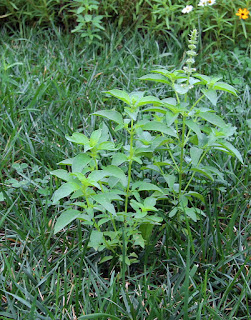 I have a very small lawn area in the front of the house. Half of the front yard is lawn, the other is my cottage garden with its tastefully arranged mix of annuals, perennials, and vegetables. The annuals are those that reseed themselves such as basils, dill, Mexican zinnias, rudbeckia, snapdragons, nicotiana, cosmos, and cleome. It's heaven for a cheap gardener like me.
I have a very small lawn area in the front of the house. Half of the front yard is lawn, the other is my cottage garden with its tastefully arranged mix of annuals, perennials, and vegetables. The annuals are those that reseed themselves such as basils, dill, Mexican zinnias, rudbeckia, snapdragons, nicotiana, cosmos, and cleome. It's heaven for a cheap gardener like me.I provide a little pre emergent herbicide on the grass (excuse me - for us Master Gardeners that's turf) to keep the crabgrass from finding a home. This year, a few lemon basil plants thought the grass area with its pre emergent looked like greener pastures and moved out into the lawn. No crabgrass from the pre emergent, but basil found a home.
Now to be fair, this is not the first time plants have jumped out of the garden and ventured out into the lawn. But it is the first time edibles have done so. Every year, some rudbeckia and cleome need to be scolded, bad boys as they are, sowing their wild oats in my grass. Nicotiana and poppies seem to delight in popping up across pavement or in the brick sidewalk cracks. But now the basil? And not just one plant, but four decided to run away from home? They are all grounded.
 You have to admit, the basil looks happy and healthy there. Yes, most of their friends remained growing in the garden bed, although most had gone to seed at this time of the year.
You have to admit, the basil looks happy and healthy there. Yes, most of their friends remained growing in the garden bed, although most had gone to seed at this time of the year.Please ignore the wild looking grass and clover in the lawn. I let these basils grow and purposely did not mow the grass, and the hot summer slowed the grass growth down. And, the grass just looks more wild than it really does in person. Enough excuses?








